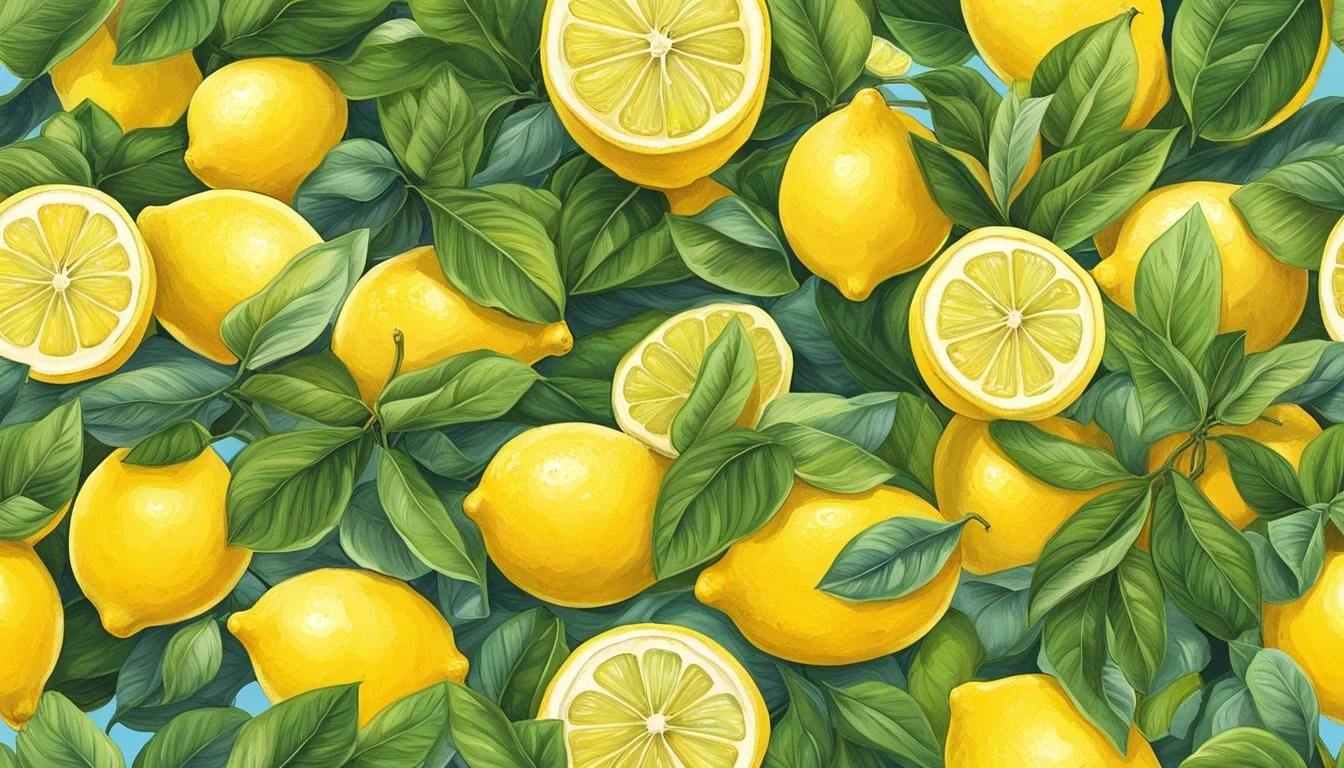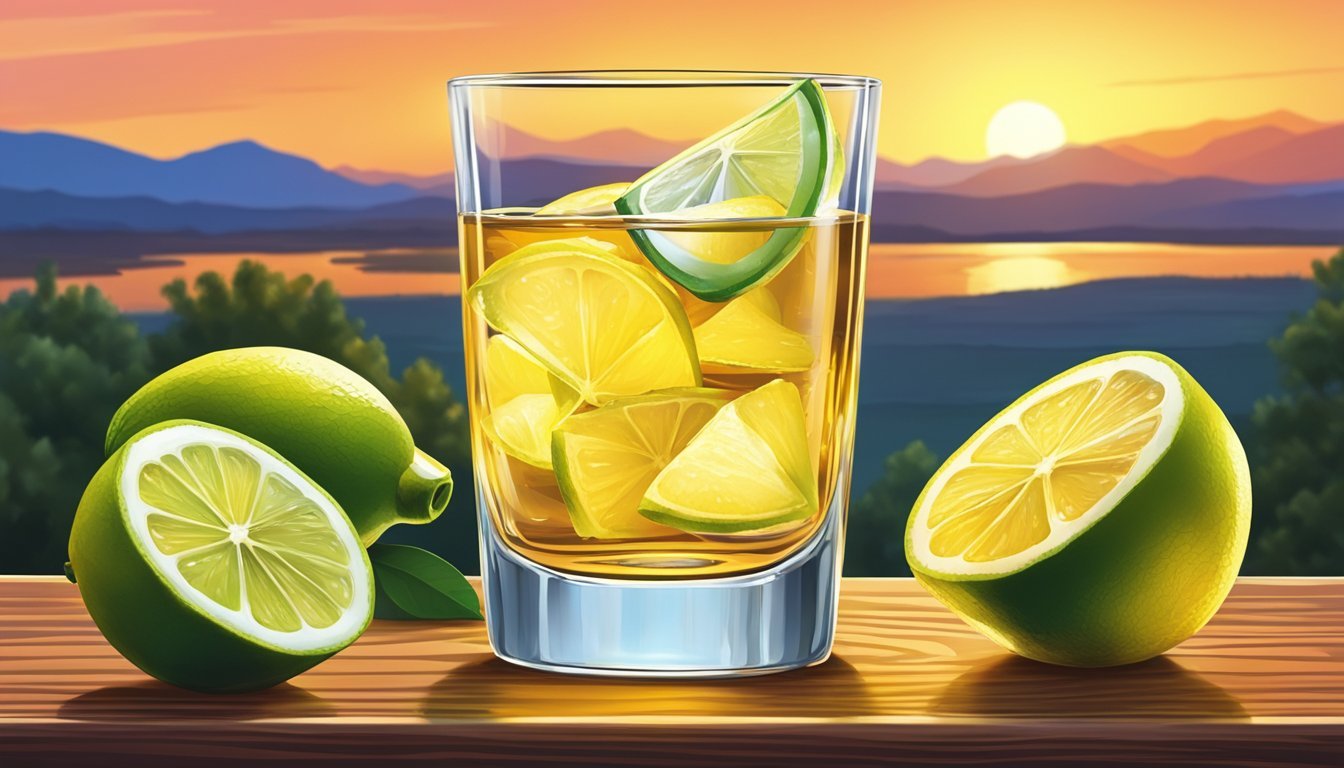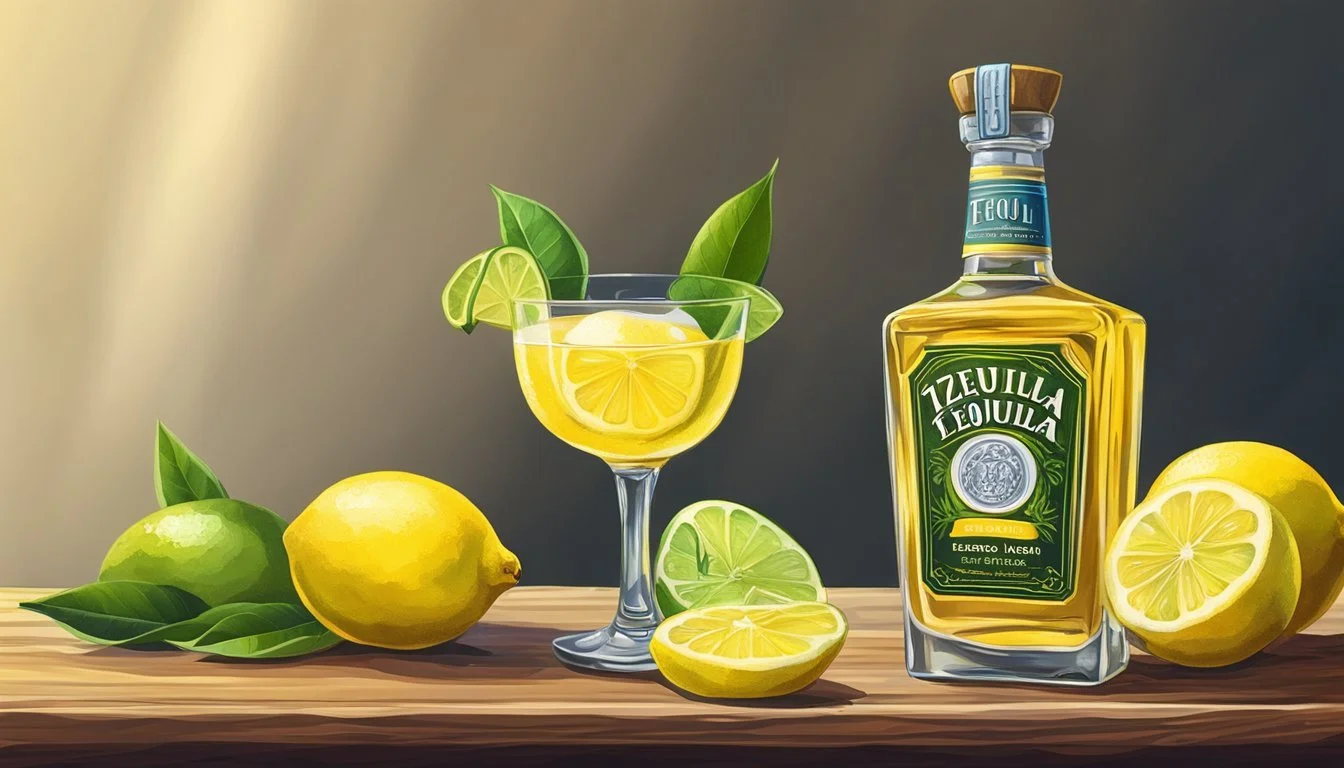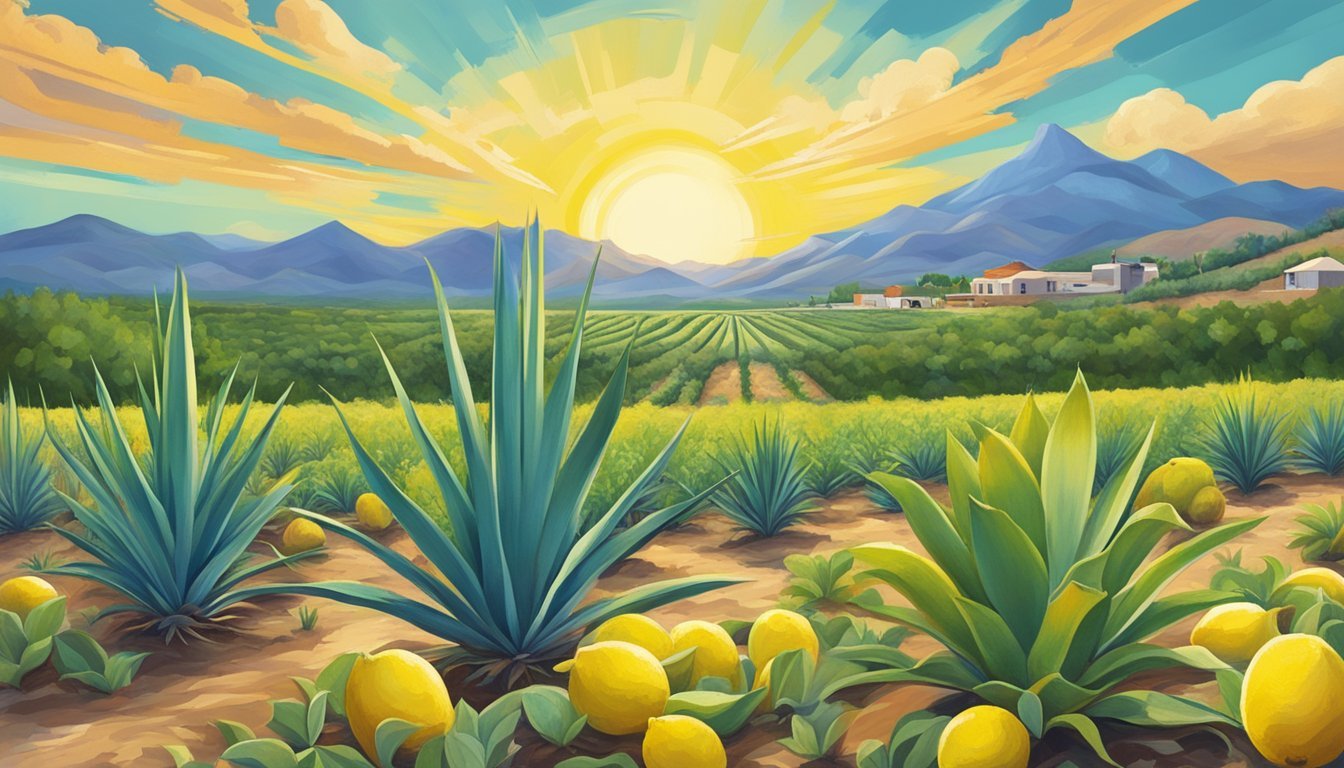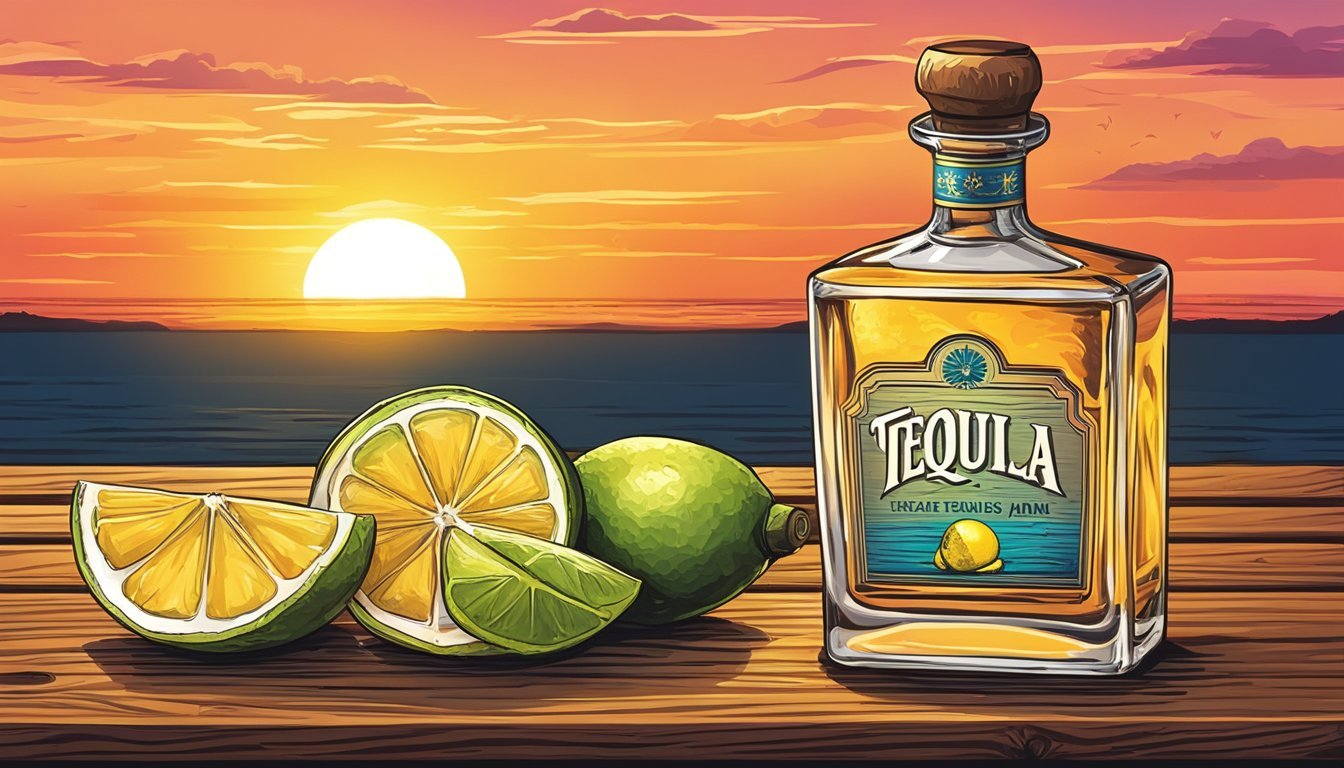Tequila and Lemon
Unveiling the Lone Star State's Spirited Duo
Tequila and lemon are storied companions in the landscape of cocktails, where the spirited punch of tequila meets the bright zest of lemon. Originating from Mexico, tequila draws its heritage from the blue agave plant and carries the essence of its sun-soaked terroir. The addition of lemon complements this complexity with a burst of citrus that enhances the liquor's natural flavors.
In Texas, where the heat and the palate crave refreshment, this combination takes on a local twist. Texans have embraced the energizing duo, incorporating it into a variety of drinks that suit long summers and social gatherings. The iconic simplicity of a tequila shot followed by a lemon wedge is a testament to their enduring appeal, but the versatility of both ingredients encourages experimentation and creativity in cocktail crafting.
Cocktails such as the classic Margarita, where tequila and lemon blend with orange liqueur and a touch of sweetness, showcase the harmony these elements can achieve. Beyond the familiar, innovative mixologists in Texas and beyond continue to explore new dimensions of tequila and lemon, finding the ideal balance that captures both the spirit's boldness and the fruit's refreshing clarity.
Exploring Tequila
In this section, readers will gain insight into the diverse types of tequila, uncover its historical roots, identify distinctive tasting notes, appreciate its role in mixology, and learn to select the best tequila for their palate.
Types of Tequila
Tequila is categorized mainly into three types based on aging: Blanco, Reposado, and Añejo. Blanco tequila, also known as silver or plata, is bottled after distillation and features a clear, sharp taste. Reposado tequila rests in oak barrels from 2 months up to a year, acquiring a golden hue and a balanced flavor. Añejo tequila, aged for 1 to 3 years, develops a dark color and complex flavors due to prolonged contact with wood.
The History and Origin of Tequila
Tequila was first produced in the 16th century near the location of the city of Tequila, which was not officially established until 1666. Its origin lies in the state of Jalisco, Mexico. The Aztecs had previously made a fermented beverage from the agave plant, which they called octli (later, pulque), long before the Spanish arrived in 1521.
Tequila Tasting Notes
Each type of tequila offers unique tasting notes:
Blanco: Crisp and fresh, it retains the pure flavors of the agave plant with notes of citrus and pepper.
Reposado: A mellower taste than Blanco, it offers hints of oak and caramel due to barrel aging.
Añejo: Known for its smoother, richer qualities and flavors including vanilla, smoke, and spices.
Tequila's Place in Mixology
Tequila is a cornerstone in mixology, famed for its adaptability in creating a wide array of tequila cocktails. Its versatility allows it to blend seamlessly with various ingredients, bolstering the drink's primary characteristics. Often associated with Mexican cuisines, its mixability extends far beyond, contributing to the vibrancy of the cocktail scene.
Selecting the Best Tequila
When selecting a tequila, one should consider the personal preference for flavor and the intended use. For a robust tequila presence in cocktails, Blanco might be ideal, whereas Añejo suits those enjoying tequila neat or in drinks where complexity is welcomed. Reposado strikes a balance between the two, suitable for sipping and diverse enough for cocktails.
The Role of Citrus
In the realm of cocktails, citrus fruits bring essential acidity and freshness, transforming simple mixtures into complex, flavorful beverages. Their role is particularly pronounced when paired with tequila in various concoctions.
Lemon's Citrus Profile
Lemon is a cornerstone citrus in cocktail-making. It offers a high concentration of citric acid, which imparts a sharp, clean tanginess that balances the sweetness of syrups and the strong character of spirits like tequila. Commonly, lemon juice is favored for its crisp flavor profile, while Meyer lemon, a sweeter alternative, can provide a more nuanced tartness to cocktails.
Other Citrus Variants
Besides lemon, other citrus fruits such as lime, orange, and grapefruit also play pivotal roles in cocktails. Lime juice tends to be slightly more acidic than lemon, delivering a punchier flavor. Orange juice offers a milder tartness with a natural sweetness. Grapefruit brings a bitter edge that complements tequila well, especially in drinks like the Paloma. Their diverse flavors allow mixologists to achieve the desired balance within a cocktail.
Lime Juice: More acidic, sharp flavor
Orange Juice: Milder tartness, natural sweetness
Grapefruit: Bitter edge, good with tequila
Enhancing Cocktails with Citrus
Citrus does more than just add flavor; it's key in achieving the right cocktail texture and mouthfeel. When making a sour cocktail, bartenders often reach for sour mix or lemonade to smooth out the edges of tequila and introduce a satisfying complexity. In addition, the addition of a citrus garnish or float can elevate the drink's aromatic appeal and add a hint of zest. Whether it's the bright splash of lemon in a tequila and lemon cocktail or the varied citrus notes in a more elaborate mix, citrus is fundamental in crafting a well-rounded drink.
Sour Mix/Lemonade: Balances and smooths tequila
Citrus Garnish: Enhances aroma and adds zest
Classic Tequila Cocktails
In this exploration of tequila-based classics, the versatility of tequila is celebrated, ranging from the timeless Margarita to the sunny Paloma, with an emphasis on how lemon elevates these beloved concoctions.
The Margarita and Its Variations
The Margarita is the quintessential tequila cocktail, traditionally blending tequila, triple sec (an orange liqueur), and lemon or lime juice. Variants like the Cadillac Margarita elevate the original by incorporating premium ingredients, whereas a Spicy Margarita adds a fiery twist with jalapeño or chili peppers.
The Paloma and Beyond
The Paloma is a refreshing marriage of tequila, grapefruit juice or grapefruit soda, and a splash of lime, often served with a salted rim. This drink showcases tequila's affinity for citrus, making it a second favorite to the Margarita in Mexico.
Innovative Tequila Mixes
Experimenting with tequila can yield delightful results. For instance, a Tequila Sour incorporates lemon juice, simple syrup, and often a dash of egg white for a frothy topping. Innovators pair tequila with unexpected mixers to craft unique cocktails, pushing the boundaries of traditional recipes.
Tequila and Lemon in Cocktails
Lemon's acidity and brightness are perfect for cutting through tequila's robust flavor profile. Tequila Lemonade combines the spirit with homemade lemonade, while a Tequila Sunrise opts for orange juice with a splash of grenadine, visually mimicking a sunrise in the glass.
Savory Tequila Concoctions
On the savory end of the spectrum, the Bloody Maria substitutes vodka in a Bloody Mary with tequila, adding a complex layer paired with tomato juice and various spices. Here, lemon serves as a garnish, adding a tangy counterpoint to the savory cocktail.
Crafting a Tequila and Lemon Cocktail
Crafting the perfect Tequila and Lemon cocktail is a delicate balance of selecting quality ingredients, using precise ratios, employing meticulous mixing techniques, followed by thoughtful garnishing and presentation for a memorable drink experience.
Ingredients and Ratios
When creating a Tequila and Lemon cocktail, the following ingredients are typically used:
Tequila: A shot (1.5 ounces) of Blanco or Anejo tequila is ideal for its clear, agave-forward flavor.
Lemon: Fresh lemon juice, typically half an ounce, adds a bright zestiness.
Sweetener: Simple syrup or honey syrup, generally a quarter ounce, balances the citrus tartness. In some recipes, orange liqueur or triple sec may be added instead for additional depth.
Bitters: Optional, a dash of Angostura or any fruit bitters can enhance the cocktail's complexity.
Proportions are key: A classic ratio to follow is 2:1:1 for tequila, sweetener, and lemon juice respectively. However, the ratio may vary based on personal preference and the specific cocktail being made.
Mixing Techniques
Shaking is the preferred mixing technique for Tequila and Lemon cocktails to thoroughly blend and chill the ingredients. Fill a shaker with ice and add the tequila, freshly squeezed lemon juice, and your choice of syrup. Securely close the shaker and vigorously shake for about 15-20 seconds to ensure proper dilution and chilling. For drinks like the Raspberry Tequila Sour, an optional egg white might be added to create a frothy texture, which is shaken first without ice (dry shake) and then with ice (wet shake).
Garnishes and Presentation
Garnishing is the final touch to enhance the visual appeal and add a hint of flavor to your cocktail:
Citrus Twist: A lemon twist not only looks elegant but also adds a burst of citrus oil.
Herbs: A basil leaf or a sprig of mint can contribute a fresh aroma and a pop of color.
Edible Flowers or Berries: Blackberries or edible flowers like violets can be used for a touch of sophistication.
In terms of presentation, Tequila and Lemon cocktails are typically served in a chilled coupe or rocks glass. The glass rim can be salted or spiced with cinnamon for an added flavor dimension, according to your cocktail variation.
Non-Alcoholic Alternatives
Non-alcoholic tequila substitutes provide a way for individuals to enjoy the bright and zesty combination of tequila and lemon without the alcohol content. These alternatives can be used in mocktails that mimic the complex flavors of traditional cocktails.
Mocktail Varieties
A Tequila Mockingbird is a popular non-alcoholic mocktail that traditionally consists of lime juice, a tequila substitute, and club soda, garnished with a lemon or lime wedge. Here's a simple recipe:
2 oz non-alcoholic tequila alternative
1 oz lime juice
4 oz club soda
Ice
Lime or lemon wedge for garnish
To prepare, one simply combines the non-alcoholic tequila and lime juice over ice, tops it with club soda, and garnishes with a citrus wedge.
Another crowd-pleaser is the Virgin Margarita, which can be crafted by blending:
2 oz non-alcoholic tequila alternative
1 oz lime juice
0.5 oz orange juice
1 tsp sweetener (like agave nectar)
Ice
Salt for the rim (optional)
Blend the ingredients until smooth, and serve in a glass with a salted rim if desired.
Using Flavor Substitutes
When crafting non-alcoholic cocktails, it's essential to use flavor substitutes that mimic the essence of tequila, such as seedlip and other non-alcoholic spirits that have an earthy and smoky profile. Club soda, sparkling water, and seltzer are excellent for adding fizz without overpowering the other delicate flavors. For sweetness and color, try including:
Grenadine: For a touch of vibrant red and a sweet tang
Pineapple juice: Adds tropical notes and sweetness
Cranberry juice: Offers a tart flavor and a ruby hue
Incorporating these elements can create a complex, satisfying drink experience akin to their alcoholic counterparts.
Pairing with Food
Tequila's versatility makes it an excellent companion for a wide array of foods. Its bright and zesty nature, especially when paired with lemon, can enhance different flavor profiles when carefully matched with suitable dishes.
Complementary Flavors
Lemon's acidity and tequila's smoothness marry well with herbal notes such as basil. One might consider a basil-infused tequila cocktail as a refreshing start to any meal. Moreover, the incorporation of cinnamon in a dish could echo the warm undertones found in aged tequilas, creating a coherent flavor experience.
Basil: Enhances the fresh elements in a tequila lemon cocktail.
Cinnamon: Warms and complements the natural sweetness of tequila, especially in a cocktail like a cinnamon margarita.
Spicy and Savory Pairings
The heat from spicy margaritas or drinks with jalapeño can cut through rich, savory dishes. For instance, a jalapeño margarita with its capsaicin kick contrasts exquisitely with creamy textures and balances the palate.
Jalapeño: Adds a spicy layer to tequila that can stand up to robust flavors in food.
Spicy Margaritas: Ideal for cutting through the fattiness of savory dishes.
Sweet and Refreshing Combinations
Tequila and lemon can be sweetened with honey syrup to pair with desserts or fruit-forward dishes. Similarly, a blackberry margarita highlights the berry's tartness while harmonizing with tequila's citrus notes. Additionally, grapefruit segments or simple syrup in a paloma cocktail complement seafood or light summer salads.
Blackberry & Honey Syrup: They introduce a sweet yet tart dimension that complements lighter tequila cocktails.
Grapefruit & Simple Syrup: Brighten the palette, perfect for pairing with lighter dishes such as seafood salads.
Cultural Impact of Tequila and Lemon
Tequila and lemon have both significantly influenced culture, from the unique tastes they bring to cocktails to the diverse ways they're celebrated in traditions.
Tequila in Popular Culture
Tequila's journey from Mexican farmlands to a global stage has been marked by its increasing popularity in a variety of settings, including films, music, and social gatherings. It has evolved into a symbol of celebration, often associated with parties and lively entertainment. Recognizable in movies and songs, tequila is frequently paired with lemon to cut through its strong flavors and add a zestful twist. The combination has become signature in cocktails, particularly in the form of tequila shots with a lemon wedge, embracing a ritual that spans across diverse cultures.
Movies: Tequila often appears as a drink of choice for characters showcasing boldness.
Songs: Celebrated in lyrics, it represents feelings of revelry or heartbreak.
Lemon's Evolution in Cuisine and Drinks
Lemon has played a vital role in culinary traditions, elevating dishes and beverages with its citrusy punch. From simple spritzes over seafood to its integration in confectioneries, lemon is versatile. In drinks, its presence is essential — it's not just a garnish, but a key ingredient that balances and brightens. Lemon's acidity is the perfect counterpoint to the robust profile of tequila, making it indispensable in cocktails like the classic margarita or refreshing lemonade blends spiked with tequila.
Cuisine:
Enhancer: Used to accentuate flavors in both savory and sweet dishes.
Versatility: Incorporated into a range of cuisines worldwide.
Drinks:
Cocktails: Lemon transforms tequila-based drinks with its zesty flavor.
Lemonade: Offers a non-alcoholic option that pairs well with tequila for a spiked version.
Responsible Consumption
When indulging in the vibrant blend of tequila and lemon in a cocktail, one must also consider the importance of alcohol responsibility. Responsible consumption is critical for both safety and enjoyment.
Tequila, a potent liquor, should be consumed in moderation. The Centers for Disease Control and Prevention (CDC) defines moderate drinking as up to one drink per day for women and up to two drinks per day for men. For cocktails, a standard drink is:
Tequila: 1.5 ounces (44 milliliters)
Individuals should pace themselves by sipping their drinks slowly. Using a timer between drinks can help maintain a moderate pace. Hydration is also key; alternating between cocktails and water can help prevent overconsumption.
Adults of legal drinking age should always plan a safe way home before enjoying tequila lemon cocktails. Choosing a designated driver or utilizing public transportation can prevent impaired driving.
Here is a summary of key points about responsible consumption:
Moderate drinking: Up to 1 drink/day for women, up to 2 drinks/day for men.
Pacing: Sip slowly, use a timer if needed.
Hydration: Alternate with water.
The appeal of tequila and lemon lies in the enjoyment it brings when shared with friends or during a relaxing moment. They should always remember the impact that overindulgence can have on their health and the well-being of others. By consuming responsibly, they can enjoy the full flavor and experience of these cocktails while ensuring safety and respect for everyone.
Conclusion
Tequila and lemon have long held a reputed place in the cocktail world. They come together to offer a zesty and invigorating blend that is both refreshing and bold. This Texan combination is not only a classic but continues to inspire innovation in cocktail making.
In their purest forms, tequila brings a smooth, agave-rich profile, while lemon adds a bright, citrus zest. When these elements are precisely balanced, they create an array of cocktails that are ideal for various occasions. Lemon Drop with Tequila is a perfect example of such an innovative twist, providing a spirited version of the traditional Lemon Drop.
Cocktail enthusiasts appreciate the versatility of the tequila and lemon pairing. It is the foundation for simple mixtures and more complex concoctions:
For Simplicity: A splash of lemon in tequila is often enough to enhance its flavor.
For Complexity: Mixes like the Birds and the Bees and the Raspberry Rose Tequila Kombucha show the depth and range this duo offers.
The joy of these cocktails lies in their balance – the boldness of the tequila is seamlessly matched with the tartness of the lemon, often with a sweet or floral note to round out the palate. Served over ice and garnished with a slice of lemon or lime, these drinks provide a burst of flavor that enlivens the senses.
As they explore the tequila and lemon combination, mixologists continue to respect the timeless nature of these ingredients while also pushing the boundaries to create new experiences for cocktail lovers. Whether it is a relaxed backyard gathering or a formal event, the tequila-lemon cocktail remains a beloved choice with the promise of a bright and zesty indulgence.


